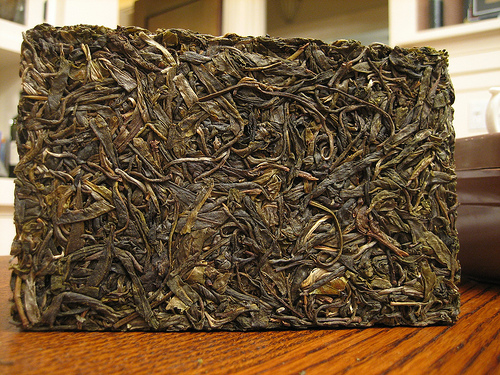 |
| Fuchs meets a lady at a waypoint on the Road |
Fuchs' chá mǎ gǔ dào trek took seven months. In order to prepare for the expedition, he learned Mandarin in Taiwan and spent three years acquiring the funds (North Face was one of his main sponsors). The tea trading route, 5000km altogether, was once a migration route for nomadic peoples also, and, although it has been used for an estimated 13 centuries, is not as familiar to the western world as is the Silk Road; its history has not been written down.
 |
| "Snogging an ancient tea tree" (on JF's website) |
At one point he met a handsome, long haired horseman (see the photograph on this page) proud of his ancestors who had been highwaymen and murderers. Every village up there has a distillery, and the people like their whisky: arra. For parts of the trek glaciers had to be crossed, sometimes 4000m thick (although the glaciers are said to be only a third the magnitude they once were). At a 6000m altitude the expedition crossed a pass that the explorers dubbed "Nosebleed Central"––the Tibetans call it "the place where the bandits rest." The mules had to be muzzled on the way there to stop them eating hallucinogenic thistles which would have driven them to leap off the precipices. One place was known as "The Valley Of Bones" because of the casualties.
The men on the tea road had to be tough, joked Fuchs, "because the women were tougher!" It was the women who proved the more reliable sources of information, too, but he showed us a picture of an old man, Mr. Wu, who said, "If you want to speak of trade, you must come and sit down and take tea with me. I speak slowly, so we will need a lot of tea." The conversation lasted three days.
 |
| A brick of pu-erh tea (Wikipedia) |
Fuchs spoke of the salt too, that used to be taken from the "salt wells", the salt lakes of Tibet, now extinct. Vultures, crows and cranes rest here during their migration. The red salts of the region are not valued by the local populace as much as in trendy California. The Tibetans feed their pigs on it.
Yunnan became part of China during the Mongolian invasions; the borders kept changing. This region is renowned for its bio-diversity, with its red clay soil of a high nitrogen content; it is the place from which the world's best shitake mushrooms are shipped, daily, to Tokyo. The country people are attracted to China's big cities, but many return home. The heart of China (a misunderstood, misrepresented country!) is in the rural areas, says Fuchs, but every home has a solar panel, these days, even in the mountains; the electricity is used to charge people's cellphones and boom-boxes. Tourism and modernity is inevitable, he adds. The question is, how it's managed. Tourists come to see the old traditions but as they do so, they destroy those traditions. It's a dilemma.

No comments:
Post a Comment